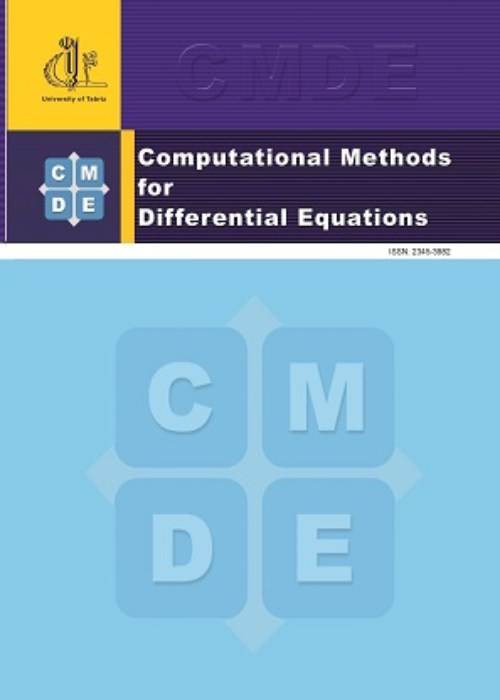فهرست مطالب
Computational Methods for Differential Equations
Volume:1 Issue: 1, Summer 2013
- تاریخ انتشار: 1392/06/17
- تعداد عناوین: 6
-
-
Pages 1-15
This paper concerns with the modeling and construction of a fifth order method for two dimensional acoustic wave equation in heterogenous media. The method is based on a standard discretization of the problem on smooth regions and a nonstandard method for nonsmooth regions. The construction of the nonstandard method is based on the special treatment of the interface using suitable jump conditions. We derive the required linear systems for evaluation of the coefficients of such a nonstandard method. The given novel modeling provides an overall fifth order numerical model for two dimensional acoustic wave equation with discontinuous coefficients.
Keywords: Interface methods, two dimensional acoustic wave equation, high order methods, Lax-Wendroff method, WENO, discontinuous coefficients, Jump conditions -
Pages 16-29In this paper, the Chebyshev spectral collocation method(CSCM) for one-dimensional linear hyperbolic telegraph equation is presented. Chebyshev spectral collocation method have become very useful in providing highly accurate solutions to partial differential equations. A straightforward implementation of these methods involves the use of spectral differentiation matrices. Firstly, we transform telegraph equation to system of partial differential equations with initial condition. Using Chebyshev differentiation matrices yields a system of ordinary differential equations. Secondly, we apply fourth order Runge-Kutta formula for the numerical integration of the system of ODEs. Numerical results verified the high accuracy of the new method, and its competitive ability compared with other newly appeared methods.Keywords: Chebyshev spectral collocation method, telegraph equation, numerical results, Runge-Kutta formula
-
Pages 30-38In this paper, we investigate the total variation diminishing property for a class of 2-stage explicit Rung-Kutta methods of order two (RK2) when applied to the numerical solution of special nonlinear initial value problems (IVPs) for (ODEs). Schemes preserving the essential physical property of diminishing total variation are of great importance in practice. Such schemes are free of spurious oscillations around discontinuities.Keywords: Initial value problem, Method of line, Total-variation-diminishing, Rung-Kutta methods
-
Pages 39-54
In this paper, we consider a coupled system of nonlinear fractional differential equations (FDEs), such that both equations have a particular perturbed terms. Using emph{Leray-Schauder} fixed point theorem, we investigate the existence and multiplicity of positive solutions for this system.
Keywords: fractional derivative, fixed point theorem, positive solution -
Pages 55-70
It is well known that the parabolic partial differential equations in two or more space dimensions with overspecified boundary data, feature in the mathematical modeling of many phenomena. In this article, an inverse problem of determining an unknown time-dependent source term of a parabolic equation in general dimensions is considered. Employing some transformations, we change the inverse problem to a Volterra integral equation of convolution-type. By using an explicit procedure based on Sinc function properties, the resulting integral equation is replaced by a system of linear algebraic equations. The convergence analysis is included, and it is shown that the error in the approximate solution is bounded in the infinity norm by the condition number and the norm of the inverse of the coefficient matrix multiplied by a factor that decays exponentially with the size of the system. Some numerical examples are given to demonstrate the computational efficiency of the method.
Keywords: Parabolic equation, Inverse problem, Sinc function -
Pages 71-77
In this paper, the modified simplest equation method is successfully implemented to find travelling wave solutions of the generalized forms $B(n,1)$ and $B(-n,1)$ of Burgers equation. This method is direct, effective and easy to calculate, and it is a powerful mathematical tool for obtaining exact travelling wave solutions of the generalized forms $B(n,1)$ and $B(-n,1)$ of Burgers equation and can be used to solve other nonlinear partial differential equations in mathematical physics.
Keywords: The modified simplest equation method, traveling wave solutions, homogeneous balance, solitary wave solutions, The generalized forms B(n, 1), B(−n, 1) of Burgers equation


